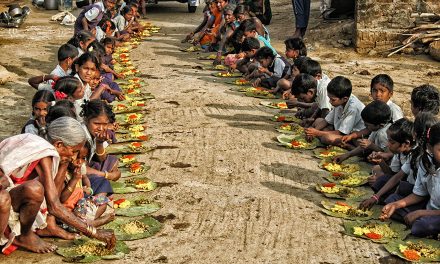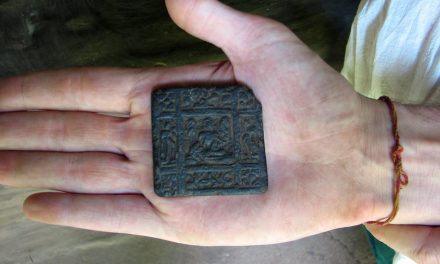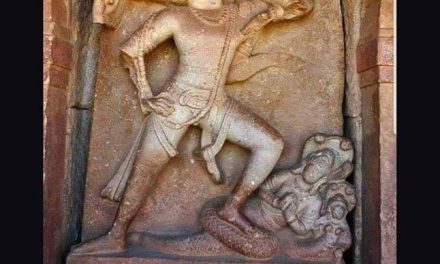(This was originally written by me in 2001 for our email newsletter, Tattva Prakasha.)
What will happen to me after death? In the second chapter of Bhagavad Gita Lord Krishna explains this subject to Arjuna in great detail. Arjuna was faced with a situation where, in order to uphold dharma, he had to fight and kill people who were very dear to him, his own relatives and friends. As one might expect, it caused great disturbance to Arjuna, and when he finally saw the people with whom he was going to fight, he lost all composure and began to cry.
Arjuna threw down his bow and told to Lord Krishna, “na yotsya”, I shall not fight.
His anxiety and grief was based on his false identification of the body as the self. He thought the self ceases to exist when the body dies. To correct this misconception and to establish Arjuna in full knowledge of the self, Lord Krishna spoke the Bhagavad Gita on the battlefield of Kurukshetra.
He began by first establishing the eternality of the soul:
na jayate mriyate va kadacin
nayam bhutva bhavita va na bhuyah
ajo nityah sasvato ’yam purano
na hanyate hanyamane sarire
“For the soul there is neither birth nor death at any time. He has not come into being, does not come into being, and will not come into being. He is unborn, eternal, ever-existing and primeval. He is not slain when the body is slain.”
The body is simply an external covering of the soul. Being material, the body is by nature temporary, and must at some point deteriorate and die. The soul on the other hand is spiritual in nature. For it there is no beginning nor end. Matter and spirit are qualitatively opposite. Whereas the matter’s natural quality is that it is temporary, full of ignorance and full of suffering, the qualities of the soul are that it is eternal (sat), full of knowledge (cit) and full of bliss (ananda).
Anything that has a beginning in time will also certainly have an end. Thus the body will inevitably come to an end, but the soul, which is beginningless, will continue its existence:
jatasya hi dhruvo mrtyur
dhruvam janma mrtasya ca
tasmad apariharye ’rthe
na tvam socitum arhasi
“One who has taken his birth is sure to die, and after death one is sure to take birth again. Therefore, in the unavoidable discharge of your duty, you should not lament.”
Krishna describes death in the Bhagavad Gita as being nothing more than a change of dress:
vasamsi jirnani yatha vihaya
navani grhnati naro ’parani
tatha sarirani vihaya jirnany
anyani samyati navani dehi
“As a person puts on new garments, giving up old ones, the soul similarly accepts new material bodies, giving up the old and useless ones.”
This body is nothing but a vehicle, and the soul is the passenger. When this vehicle is no longer suitable for the soul, due to old age and decay, the soul is given a new vehicle. Thus death is simply the transition from one vehicle to the next.
dehino ’smin yatha dehe
kaumaram yauvanam jara
tatha dehantara-praptir
dhiras tatra na muhyati
“As the embodied soul continuously passes, in this body, from boyhood to youth to old age, the soul similarly passes into another body at death. A sober person is not bewildered by such a change.”
The soul is actually covered by two bodies, one physical (sthula-sarira) and one subtle (sukshma sarira). The physical body is composed of the elements earth, water, fire, air and ether. This is what people generally think of as themselves – what they see in the mirror. The subtle body is composed of mind (manas), intelligence (buddhi) and false identification (ahankara). This subtle body stores all of the thoughts, desires, and experiences one has had, in every single life one has lived. As each new life comes, the experiences of the older lives are pushed deeper and deeper inside, thus they are forgotten. Sometimes these inner thoughts again resurface due to a dramatic occurrence or due to meditation and sadhana. In the case of a dramatic occurrence, the result is confusion, as the person cannot figure out which life is actually his. In the case of meditation, the yogi develops full conviction that he is not the body, and the lives he has experienced are not the reality.
It is the subtle body which carries the soul to his next destination at the time of death. From the time of the soul’s original embodiment in matter it has possessed the same subtle body, regardless of the external bodies it had. At death the physical body changes, but the subtle body continues with the soul. Only at the time of liberation is the subtle body finally cast off, diffused back into the cosmic elements.
What determines the body one will go to at the time of death? Krishna answers this question as follows:
yam yam vapi smaran bhavam
tyajaty ante kalevaram
tam tam evaiti kaunteya
sada tad-bhava-bhavitah
“Whatever state of being one remembers when he quits his body, O son of Kunti, that state he will attain without fail.”
According to our consciousness at the time of death we receive a suitable body. What we remember at the time of death is not just a matter of the momentary thought that occurs. What we have done throughout our entire life will naturally come to our mind as we leave our body. Just prior to death, our entire life is flashed before our mind’s eye in a split second. One particular event will be very attractive to us, and we will focus on that. Based on that desire we will be given our next body, sometimes higher and sometimes lower.
If our mind focuses on an activity which is very ignorant (tamo-guna), we will receive a suitable body among the lower species of life – as a plant, a fish, a tree, or an animal.
If our mind focuses on an activity which is passionate (rajo-guna), we will be given a body within the human categories of life.
If our mind focuses on an activity which is primarily within the mode of goodness (sattva-guna), we will recieve a body on one of the higher planets – svarga-loka, etc.
Again I will mention that our mind will focus on an activity based on how we have lived our entire life. It is not possible to suddenly make our consciousness pure if we have spent our entire life engaging in improper activity.
The ultimate result of this transmigration from one body to the next is that we have tied one more knot in the rope of attachment which binds us to this material world. No matter what the destination, it is still not a victory. Which ever body we receive, we are still embodied – it is an artificial covering entrapping us.
Krishna describes this entire universe as duhkhalayam ashashvatam – temporary and full of suffering. No matter which body one has, these two qualities are there. But there is an alternative, a solution to this seemingly endless cycle. Krishna says:
anta-kale ca mam eva
smaran muktva kalevaram
yah prayati sa mad-bhavam
yati nasty atra samshayah
“And whoever, at the end of his life, quits his body, remembering Me alone, at once attains My nature. Of this there is no doubt.”
If we are able to remember Lord Krishna at the time of death, we will become free from the external covering of the body and attain His eternal abode. This sounds very simple, but again it is not such an easy thing. Death is the ultimate test we must all face. What will be our consciousness at that moment? For those who are attached to the body due to identifying the body as the self, death is the most difficult occurrence. The soul is forced out of the body, despite his attempts to remain within it. I cannot describe the tremendous pain one who is attached to the body goes through at death. But I can say it is greater than anything else one can experience in life.
For the self-realized devotee the situation is completely different. He understands he is not the body. He knows the body is just a vehicle, a machine, and as such he has no attachment to the external body. For him death is as simple as opening a door and walking through it. Every day when we go outside our house we open the door and walk out. It is not a dramatic event. It is practically a non-event. This is what the devotee experiences at the time of death. Because of his realization of the self he has no attachment or false identification with the body.
And because his consciousness is always fixed on the Lord, his destination is complete freedom from the cycle of birth and death:
mam upetya punar janma
duhkhalayam asasvatam
napnuvanti mahatmanah
samsiddhim paramam gatah
“After attaining Me, the great souls, who are yogis in devotion, never return to this temporary world, which is full of miseries, because they have attained the highest perfection.”
The devotee is resituated in his constitutional spiritual position, free from all external material coverings. This is mukti, or liberation – attainment of the surpeme abode of Vaikuntha:
na tad bhashayate suryo
na sashanko na pavakah
yad gatva na nivartante
tad dhama paramam mama
“That supreme abode of Mine is not illumined by the sun or moon, nor by fire or electricity. Those who reach it never return to this material world.”
We are all part and parcel of God. Our true nature is spiritual, sacidananda svarupo ‘ham sivo ‘ham sivo ‘ham. Due to false identification with the body we are covered by illusion and forced to undergo birth and death. The soul is 10,000 times more effulgent than the sun, but the covering of ignorance is so strong that we appear to be like dead matter.
The Upanishads advise us to move from darkness to light, from the temporary to the eternal, from death to immortality.
vidyayamritam ashnute
“By cultivating spiritual knowledge one attains immortality.”
Death is not something to be feared, but something we must conquer. Excessive attachment for material things puts a man into a fearful condition of existence – bhayam dvitiyabhinivesatah syat. Because we are attached to the material body, due to ignorance of our spiritual self, we therefore fear death. By cultivating transcendental knowledge of the self, and by advancing spiritually through practice of sadhana, we can separate attachment to the body and become fearless.
This is actually the goal of life – to move from death to immortality. Not immortality of the body, for the body is not actually alive at any time, but the realization of the soul’s eternal, blissful nature.
Such a realization is possible only by sincere practice of sadhana and devotional service to Lord Krishna. This was Krishna’s message to Arjuna, and it is His message to each and everyone of us.
man-mana bhava mad-bhakto
mad-yaji mam namaskuru
mam evaisyasi satyam te
pratijane priyo ’si me
“Always think of Me, become My devotee, worship Me and offer your homage unto Me. Thus you will come to Me without fail. I promise you this because you are My very dear friend.”
Will I continue my current family relationships even after death?
As two straws float in a river, and sometimes touch and sometimes separate, so in the same way our karma causes us to form temporary relationships with other living entities in this world. These relationships are not eternal. First we must understand that the identities which we are relating to are themselves not eternal. For example, my mother is an eternal spirit soul. At present her soul is situated within the body of a woman, and I am calling her as mother. In her previous life, or in her next life, she may have the body of a man. How can I continue to relate to her as mother? That relationship which depends on the body is as temporary as the body.
But there is an eternal relationship which we have with everyone. We are all part and parcel of God, and our constitutional position is in the spiritual realm. Since we are all spirit souls, part and parcel of God, we are all eternally related. At present due to the covering of illusion we do not know what our spiritual relationships are to each other. Only when we purify our own consciousness through sadhana can we know our own real identity and the identities of others. Based on those spiritual identities we will have spiritual relationships.
From time immemorial we have been passing through many, many species of life. Naturally we have had many mothers, sometimes a spider mother, sometimes a dog mother, sometimes a human mother. By the mercy of the Lord we are given forgetfulness at the time of birth so that the attachments of our previous life are buried deep within our consciousness. These countless relationships we have passed through are all reflections of our true relationships in the spiritual realm.
Knowing that we are all spirit souls, and not the external bodily covering, we should work for the spiritual upliftment of all our family members. By reestablishing someone’s eternal spiritual relationship we are truly helping our loved ones, not just their temporary body. This is actual compassion. No one knows where compassion should be applied. Compassion for the dress of a drowning man is senseless. A man fallen in the ocean of nescience cannot be saved simply by rescuing his outward dress – the gross material body.
If you take up a daily practice of sadhana you will become free from fear. Study the Bhagavad gita to develop spiritual knowledge and take up nama-japa sadhana. By chanting the names of Krishna you will be able to cross over death:
hare krishna hare krishna krishna krishna hare hare
hare rama hare rama rama rama hare hare
Questions and Answers:
Question: I was curious as to why the Ramayana seems to have been embraced culturally by much of Southeast Asia. If you look at Bali, Cambodia, etc., you see that much of their art, dance, etc., revolves around this Indian epic. How is it that the Ramayana has taken hold throughout south east Asia while other Indian traditions are not as strong. What is it in the Ramayana that speaks to such a vast range of people?
The reason why the Ramayana is present in every asian country is because the pastimes of Ramachandra took place in each of those countries in different Treta yugas. Rama’s incarnation takes place in every Treta yuga, and in each incarnation the pastimes have slight variations, including the location of Ravana’s kingdom. The most recent incarnation of Rama is recorded in the Valmiki Ramayana, in which Ravana’s kingdom was the island of Lanka.
The ancient island of Lanka actually has no connection with the present island of Ceylon. According to the Ramayana of Valmiki, Sri Lanka was located 800 miles south of the the Indian coast. If we take into account the geography mentioned in various puranas and ancient histories, we also see that the southern coast of India previously extended much further than it does at present. For example, there were three different cities that had the name Madurai in different periods. As the coast receded, each city became submerged in water, and a new “Madurai” was formed further inland. Thus, the exact location of where Sri Lanka was will be hard to ascertain, but certainly it was a distant land. That island of Lanka is no longer present, as it was submerged within the ocean.
In other Treta yugas, Ravana’s kingdom was located in other places, such as Indonesia and China. In Indonesia, Ravana’s main form was that of a bear, and in China he utilized the body of a dragon. In Valmiki Ramayana we find that Ravana had a wife from every species of life, and he assumed suitable bodies to interact with them. But his original form in this Treta yuga was human-like. In the other Treta yugas his original form was not always human-like, as was the case in China and Indonesia.
In the Puranas we also find descriptions of Rama avataras from other Treta yugas. There is even a conversation between Sita Devi and Rama, where Rama is refusing to allow Sita to enter the forest with Him. In response Sita Devi says, “If you don’t let me come, You will be the first Rama who doesn’t allow His wife to accompany Him into the forest.” There are several other places where such conversations take place.
The basic reason why the Ramayana is present in each asian country is because it is their own ancient history, whereas the Mahabharata and the Puranas are more centered on India. Even in the case of Mahabharata you find Russian tales about a man corresponding to Bhima. This is because Bhima visited Russia while collecting taxes for Yudhisthira’s sacrifice.
Question: If the cows are protected by Lord Krishna, then no force on this world should be able to harm the cows. Why then is there so much slaughtering of cows going on in this world?
The cows which Krishna personally tends and protects are not the mundane cows of this material world. They are the surabhi cows of the spiritual realm of Vaikuntha: lakshavrteshu surabhir abhipalayantam. The supreme transcendental realm is called ‘Goloka’ because it is the abode of ‘go’, transcendental cows, and ‘gopa’, transcendental cowherds. These transcendental cows are the greatest devotees of the Lord.
Krishna also provides protection to the mundane cows of this world, but in an indirect way. For their protection he establishes the principles of religion and the Vedic culture. Krishna is the protector of dharma, but in order to accommodate the free will of the living entities, sometimes He allows dharma to become degraded, and as a result the cows (and the entire world) are mistreated. At such a time, the Lord will incarnate to reestablish the principles of religion. Of course the true protection the Lord gives his devotees goes much beyond this. He does not protect us from death, He actually protects us from life – life in this material existence. People with a very limited vision of existence think death is our enemy, and we must prolong this life as much as possible. But those with a spiritual vision understand that the soul is eternal, and he will continue his journey in his next body. As such, our need no longer becomes protection from death, as death! is nothing more than a passing phase of one body. We actually need to be protected from this life and attachment to its false bodily possessions.
The Lord’s protection is absolute. He is protecting each and everyone of us. Some people he protects from death, other’s he protects from life. In both cases He is protecting them, because he is seeing to the protection of their eternal soul, and not just their external body. The entire material creation is for the protection of the living entities. Krishna is drawing us back towards His spiritual abode. From the perspective of eternal time, one life span, or even a thousand life spans, are not very significant. The actual purpose of the Lord’s incarnations is to reclaim the fallen conditioned souls through His transcendental association. This is the Lord’s true protection, which he gives very freely to the cows of Vrindavana.
The cows of this world are the material reflections of the spiritual cows of Vaikuntha. As such, the Lord blesses them by basing the entire Vedic culture on their protection. The Vedic culture is centered on sacrifice, and for sacrifice one requires ghee. Thus it is the cows which allow man to worship the Lord through sacrifice. The cows provide man with milk, ghee, and curds, all of which were essential in the worship of the Lord. Now due to the influence of the age of Kali, sacrifice to the Lord has stopped, and as a result the cows are neglected, despite the immense service they perform for society.
The Vedic literatures state that protection must be given to the weak and helpless living entities by the stronger members of society. It is the duty of a householder to protect and provide not only for one’s family, but even for the ants that live within one’s house. What to speak of higher living entities like the cow, who are at the mercy of their owners. The scriptures state that the cow is our mother. We drink the milk from the cow, therefore we must accept her as our mother and protect her. As such how can a civilized society allow violence to come to such helpless living entities, who sustain us all with their milk.
All these rules and regulations in the scriptures are given by the Lord for the protection of the cows. When these rules are not followed, and when the world turns away from the injunctions of the scriptures by violating the rights of the helpless, at that time the Lord descends to reestablish the principles of religion, to punish the miscreants and to protect his devotees.
Question: It is believed that human beings err because of the limitations in the nervous system that carry information from the external world to the brain for processing. How does yoga and meditation help in this?
The limitation of the human being is due to its unfixed mind. The yoga system identifies the root cause of this, and provides a complete solution based on its system of yama (rules) and niyama (regulations). There are eight steps of the ashtanga-yoga system which gradually bring one up to the point of perfection (samadhi). Before one begins the breathing exercises (pranayama), the sitting postures (asana) and the meditation, one must first purify his existence through various rules and regulations. This is explained in the Vedas as follows:
ahara-shudhau sattva shudhi sattva shuddhau dhruva-smritih
smriti-lambhe sarva granthinam vipramokshah
“By eating sanctified foods, one’s existence becomes purified. By the purification of one’s existence finer tissues in the memory become sanctified. When the finer tissues of remembrance become sanctified, all the knots within become untied.”
Thus the yoga system begins from the point of eating. We must regulate our selves starting with our food; and by this our existence becomes pure. As our existence is purified, the finer tissues in the memory develop. The knots in the nervous system become untied when the finer memory tissues are developed. Having come to this point one may actually begin yoga. Without coming to this stage of purification, any yoga endeavour is nothing more than gymnastics.
One who has developed this qualification to undertake yoga already has crossed the limitations you have mentioned.










